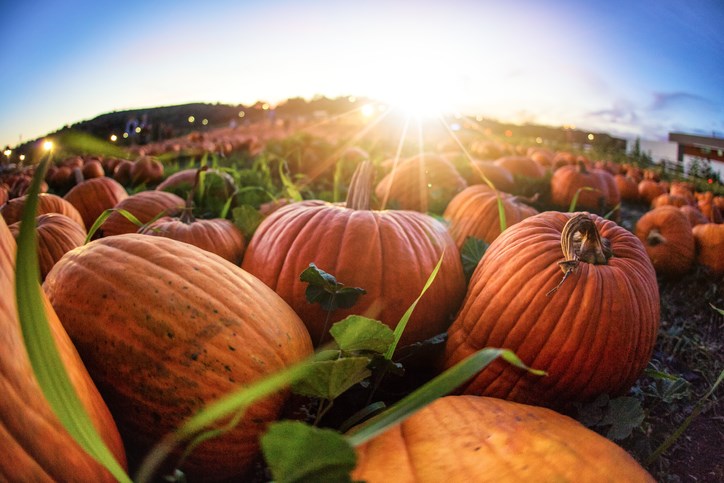Halloween and horticulture are forever linked. For gardeners, this time of year usually means the last opportunity to water in our favourite trees and shrubs before winter sets in. It also means avid gardeners have a bit more time that many use to display their harvests with great creativity.
Halloween also means pumpkins. This great vegetable becomes pies, tarts and muffins but also becomes Jack-o-Lanterns. In the 1800s with the wave of Irish immigrants the tradition of carving Jack-o-Lanterns came to our continent. Traditionally these scary demon faces were carved out of turnips and were meant to frighten away evil spirits. However, the Irish quickly determined that pumpkins were readily available, easier to carve and much more colourful.
There is a story behind the Jack-o-Lantern. The legend goes that a stingy, miserable old man named Jack liked to play tricks on everyone including his family, friends and even the Devil himself. It is said he once tricked the Devil to climb up an apple tree and while up there, Stingy Jack placed crosses around the base that effectively trapped the Devil up the tree. He then made a deal with the Devil that if the Devil promised to not take his soul when he died, he would remove the crosses and let him down.
Many years later when Jack did die he was turned away from the pearly gates because he had led a worthless life on earth. The Devil kept his promise to not take his soul and Jack became frightened as he realized he had nowhere to go and would be destined to forever wander the darkness. Out of pity, the Devil tossed Jack an ember to help him light his way.
All his mortal life Stingy Jack loved to eat turnips and just so happened to have one along for this journey. He quickly hollowed out the turnip and placed the ember inside. It is said that Stingy Jack is still walking with his Jack-o-lantern looking for a place to stay.
For many at Halloween it is customary to decorate with cornstalks, autumn leaves and apples. This tradition had its origins in the Druid autumn festival called Samhain – one of the ancient fire festivals. It was not only a harvest festival but also a time to sooth the powers that control the processes of nature. I am told that Samhain is the Witch’s word of Celtic origin for Allhallows Eve.
Most of our modern day Halloween traditions date back to Samhain and with that the belief that the changing of the seasons and most particularly the change that marks the end of summer was a magical time – a time when those that were part of the living world were most closely connected to the world of the dead.
Apples are commonly used now for great Halloween party games, but in the Victorian era, they played another important role. Maidens would slip an apple under her pillow on the eve of Halloween to be sure she would dream of her sweetheart. Alternatively, at midnight on Halloween she would stand in front of a mirror and brush her hair three times while eating an apple. The vision of her future husband would appear in the mirror over her shoulder.
In England, if a maiden could not choose between two suitors, on Halloween night she would throw a pair of hazelnuts into the fire. The nut that burned the brightest or popped the loudest indicated which man was to be hers. This night in England became known as nutcrack night.
In Mediterranean countries before the 14th century rosemary would be placed over the cradle of babes to protect them. It was also often burned along with juniper and thyme as a means of cleansing a room of bad spirits. Rue was hung from doorways and windows to ward off evil spirits and to prevent them from entering the house
Salvia was considered a symbol of immortality. When planted on graves it was believed to give the dead eternal life. This of course would have bearing on the traditional thought that Halloween was based on the ancient Allhallows Eve which was believed to be the one day of the year when dead spirits were allowed to walk the earth.
Wolfsbane, which is also commonly known as aconitum or monkshood, was believed to ward off werewolves. Garlic of course is not only important in the kitchen but is also a great way to generally ward off demons and vampires.
The words of Shakespeare in Macbeth are also filled with herbal lore. Picture the famous scene with the witches’ brew. Many would claim that the important ingredients of that brew were herbal rather than animal in nature. Scale of dragon, tooth of wolf could simply be translated to a leaf of dragonwort and a leaf of wolfsbane. Toe of frog is easily translated for those botany buffs to ranunculus or buttercup as the Latin root of rana means frog so could easily have been the root or “toe” of a buttercup flower. I would imagine that these “herbal” ingredients would have been easier to gather and infinitely more flavourful!
So to all of you, regardless of your roots – enjoy the plants that are historically associated with this time of year.
Hanbidge is the lead horticulturist with Orchid Horticulture.



